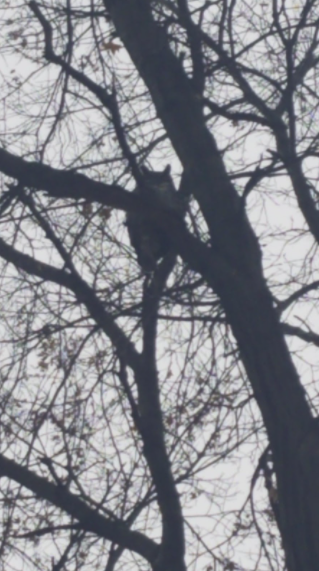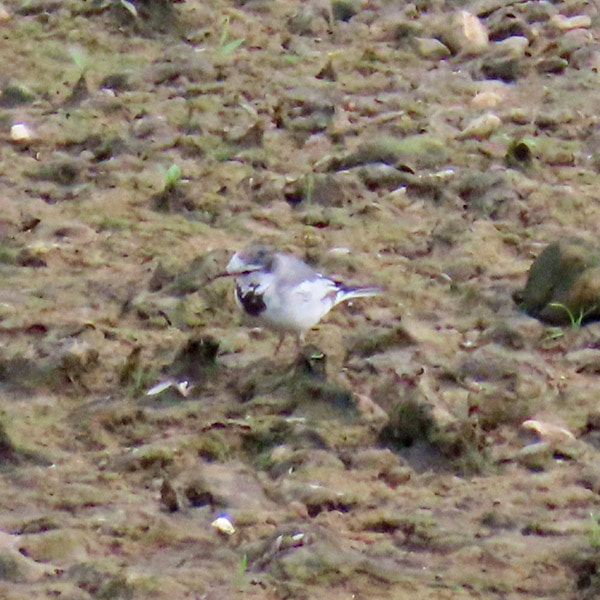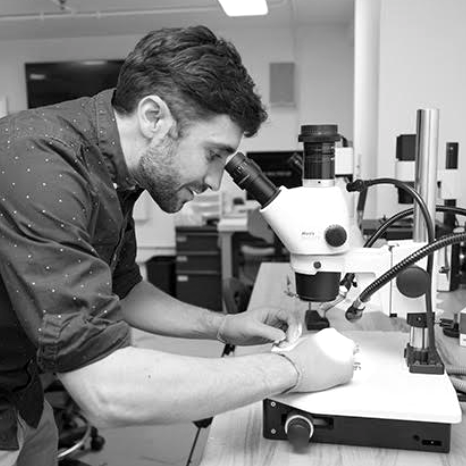|
Andy Kristin and I have been working on a lot of concepts in the last few weeks; our collaboration has been really insightful for me. I think that even though I have a foot in the world of science and the world of art, I very much thought that our thought processes were very different, but I feel a strong and true kinship with Kristin, although I do appreciate our differences. There are a few concepts we’re batting around right now, and they involve a few concepts as they gel into a potential project: data, the organisms hidden in plain sight, and storytelling. And so I thought I’d share two things this week. First, yesterday was National Bird Day, so I thought I’d share this picture: My boyfriend and I were walking through a local forest preserve (Which one? Don’t worry about it. Great Horned Owls are territorial and mate for life. The owls we saw are likely staying put for the winter, and I want people to leave them alone), and we spotted two Great Horned Owls. We were wandering along a path, and I noticed a number of droppings on the path and decided to look up. And there was an annoyingly loud little hairless ape wandering along pestering his boyfriend, and so one of the owls peered out and looked down. And we stared at each other for a while. Great Horned Owls are the largest owls in Illinois, and they can be found throughout the Americas. They are of the genus Bubo, which I find to be an adorable name, and hunt mainly rodents. We saw two Red Tailed Hawks in a prairie on the way into the forest, and the two species are very similar, only one is diurnal and one is nocturnal. Great Horned Owls are not endangered or even vulnerable; the IUCN has stated that is of the least concern. I asked a bunch of friends if they’ve seen a Great Horned Owl. I was so excited to see it that I may have told way too many people about it in the last few days. Only a handful had ever seen a Great Horned Owl, let a lone an owl in general. And this is a large bird; one of the largest in our area. In my discussions with friends, I kept thinking about conversations I’ve had with Kristin; how many species are around us that we have no idea are there and that we are unaware of. Sometimes, they’re too small. Sometimes, they are too well camouflaged. Sometimes they just are only out in the evening and nights, and it’s really cold at night these days. We’re so often unaware of the world around us, but it has so many wonders to give us. My boyfriend keeps making fun of me for how excited I got seeing the owls. Did I mention that I saw two Great Horned Owls? Less than 10 miles from my home! I’m still happy as a clam about that. I wonder how many clam species were in the North Branch of the Chicago River that my boyfriend and I walked over as we made our way into the woods. The second thing I want to talk about was the monarch butterfly. As Kristin and I are doing research around the world, I stumbled upon a fact that absolutely shocked me. I’m well aware that the western monarch butterfly, one of many populations of migratory members of the species are disappearing and threatened. It’s largely loss of overwintering sites along the West Coast and in Mexico. I love the monarch. I like seeing them in Chicago and throughout the state of Illinois. Monarchs are our state insect. But I didn’t know they live in Australia. Milkweeds and other plants were introduced around the world accidentally and as ornamental plants as soon as Europeans started making their way around the world. In the late 1800’s, people released monarch butterflies in Australia, potentially to eat the invasive milkweeds, but it’s likely that they had already made their way to this part of the world. I wanted to just bring up how strange it is to think of this beautiful butterfly that I constantly worry about being endangered as an invasive species. They aren’t alone. Many species are thriving as invasive species and hurting in their native range. What organisms are supposed to be where they are? And what species are around us that we don’t even know about? Things I keep thinking about. Kristin The world is an oyster and you go down a rabbit hole. Andy and I set out to research pairs of species with codependent relationships at specific times of year. Species movement could lead us from one ecosystem to another where we could find new codependent pairings. I was eager to dive into this research but like the White (East Siberian) Wagtail that wintered in Austin last year and drew thousands of bird watchers from around the country to a small neighborhood park, my research journey took me off course and down multiple rabbit holes. To the backdrop of unprecedented changes to climate and migration, questions have been forming around how I want to use data. How reliable are existing data sets for the purpose of this project with ecosystems shifting as they are today. Over the past few years I have been gradually letting go of expectations that species I am familiar with will be reliably present in locations where I have previously encountered them.
I started with my yard: Cats and Geckos. Feral cats reproduce multiple times a year in my neighborhood which is situated near a greenway, park, river and a migratory flyway. They are a menace to the birds but close relationship with a feral queen led to an interesting observation; cats eat House Geckos and Mediterranean Geckos—introduced invasive species in Texas—and Geckos carry liver flukes that can become fatal to cats if they get lodged in their bile duct. Mama hunts geckos all day long. The cats stay close to home and the geckos stick to the urban environment. I couldn’t find a clear path out of Austin. The Cedar Waxwings have returned. I know where to find them but I don’t know anything about the trees they perch on or the role they play in my local ecosystem. Why are they in Austin—now? Through internet resources, I learned the waxwings are here to forage on berry-fruit bearing trees, such as the Ashe Juniper, Hackberry and Yaupon Holly. I have berries in my yard but they are none of the above. I have three trees in my yard producing berries but their leaves have smooth edges, ruling these species out, and in fact I have not seen a bird within ten feet of them. The Yaupon Holly happens to be the only naturally caffeinated plant species in North America and it is native to Central Texas and a couple of other Southern states. Yaupon leaves were brewed by indigenous peoples to create a ritual drink that is likened to Yerba Mate. But the hot spots for waxwings are the upper branches of tall trees that have shed their leaves. I don’t see any berries through my binoculars. I presume this tree species is dependent on species like Cedar Waxwings and Eastern Bluebirds who pass berry seeds through their digestive system, propagating the species by dispersing seeds to other areas they move between. I have only seen blue-berries in Austin.
1 Comment
Brandon Daniel
2/12/2021 08:54:49 am
Have you returned to see the owls? Are they still there?
Reply
Leave a Reply. |






